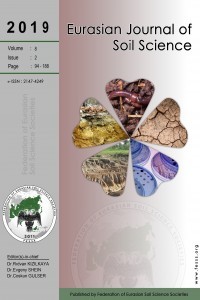
Eurasian Journal of Soil Science
Yazarlar: Khadijeh Salari NİK, Mohsen NAEL, Ghasem ASSADİAN, Ali Akbar Safari SİNEGANİ, Soheila Javaheri KHA
Konular:-
DOI:10.18393/ejss.34853
Anahtar Kelimeler:Soil quality,Vegetation type,Active carbon,Carbohydrate
Özet: Soil is an environmental component permanently changing due to the often cyclic processes of litter supply and vegetation cover. To investigate the influence of vegetation type on soil carbon fractions, six vegetation types, including rainfed wheat (RW), grasses (G), Astragallus–Bromus (A-B), Astragallus–lactuca (A-L), Astragallus–Artemisi (A-A), Astragallus–Euphorbia (A-E) were studied in similar environmental conditions in terms of parent material and slope aspect in Gonbad watershed, Hamadan. Total organic carbon (TOC), active carbon (AC), soil carbohydrates (Ch) and basal respiration (BR) were measured in surface soils (0-15 cm) in fall and spring. TOC, CH, and BR were significantly greater in A-B and A-A than other covers. A-B and A-A showed higher vegetation cover and litter compared to other types. TOC and Ch in RW and G were significantly lower than other types. The highest (711.7 mg/kg) and lowest (262.6 mg/kg) AC were observed in A-B and RW, respectively. RW had lowest values of selected soil quality indicators due to tillage and cultivation. The content of TOC and AC were significantly higher in spring than autumn. Amount of BR and Ch showed no significant difference in the two seasons. Significant positive correlations were observed between soil quality indicators, these correlations were stronger in spring than in autumn. In autumn, the highest correlations were observed between AC and Ch (0.701), as well as AC and BR (0.441). In spring, significant correlations were observed between all soil quality indicators at 1% level. It was concluded that AC and Ch are the most sensitive soil quality indicators that reflect land use and vegetation type differences.